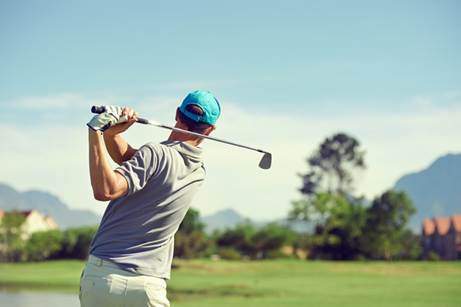
It’s no wonder that golf lovers from all over the country flock to Arizona to enjoy over 300 traditional and challenging golf courses. Whether you have the privilege to live in this great state or swing by occasionally for a visit, the last thing you want to take with you to the golf course is pain. Unfortunately, many golfers suffer from mild to moderate pain and continue to golf through it or even decide to leave the green altogether. We want you to spend more time improving your swing than sitting on the sidelines pain. It’s time to see what pain is preventing you from golfing to your max and what you can do about it.
1.Lower Back
One of the biggest problems areas for you and your golf swing is likely your back. If you experience pain in your lower back, you are likely experiencing pain in your golf swing. The motion of the golf swing includes rotation of the pelvis producing a torque between your lumbar spine and pelvis. During the swing, you will experience pulling on the ligaments, tendons and muscles of your lower back, especially when going for a power swing.
In more serious cases, you may even begin to wear down your discs between your vertebrae and lumbar spine. This can lead to disc disease and even the end of your golfing legacy.
Prevention:
While it may reduce your power, the key to lower back injury prevention lies in uniting the rotation of your pelvis and trunk, especially on your downswing. You might have been taught to separate the movement to gain power, but you’d also be sacrificing your back doing this. To stay in the game, give up some power and keep your back healthy.
2.Shoulder
Many sports, including golf, have a high risk of shoulder injury. There are many athletes that will suffer from a rotator cuff injury which can be very painful and hard to recover from. The rotator cuff is comprised of muscles and tendons surrounding the shoulder joint. When you repeatedly swing the golf club, especially incorrectly, you place a lot of stress on the shoulder joint. This can cause a tear in your rotator cuff.
Also becoming a popular golfing injury is a labral tear or torn cartilage. Around the shoulder socket is a firm piece of tissue called the labrum which helps to keep you arm in you shoulder socket. Golf swings unfortunately have a habit of tearing this cartilage as well.
Prevention:
The key here is turning. Once you master turning your upper body correctly, you’ll decrease the chances of tearing up your shoulder. If you are not turning correctly, you’ll notice your left arm pinned across your chest. Remember to use your arms as a pendulum and swing more with them than the muscles in your shoulder. In the swing, once your body stops rotating is when your swing should stop too.
3.Elbow
Believe it or not, tennis elbow happens to golfers too. Also known as lateral epicondylitis, tennis elbow happens in golf because our extensor tendons become inflamed due the constant impact of the outside elbow during the golf swing. You’ll feel pain and tenderness on the outside of your elbow if you’ve suffered from tennis elbow.
Prevention:
Focusing on how you use your elbow during your swing will help eliminate further damage. While your lead arm should remain straight, it should not be locked during your swing. You arm should be straight and relaxed at the same time. During your downswing, you’ll notice that your arm will automatically become straight because of the momentum. Locking your arm will increase your odds of adding tennis elbow to your problem list.
Treatment Consideration:
The first step to treatment is admitting you have a problem. If any sort of pain is keeping you from the green, then you have a problem. On occasion with mild pain, it may just take rest and maybe a few doses of NSAIDs to get you back out on the course. When your pain becomes more serious, a consultation at one our 3 valley locations will likely be necessary. We’ll begin with an exam and then determine your best course of recovery. You may need to just start with a little physical therapy and adjustment to your golf swing.
If you require more advanced options, we will discuss your best chance for success. We offer services like nonsurgical spinal decompression, spinal cord stimulation, injections and regenerative medicine through Apex Biologix. A proper consultation with our office will provide the best outcome and the quickest and safest way to return to your golf swing.
Our goal (and yours) is to have you back out swinging on the golf course as quickly as possible. Identifying your trouble area is the first step. You might be fortunate enough to correct your pain through modifying your swing. If that doesn’t cure the discomfort, then an informative consultation at one of our valley locations will do the trick. We’ll help you get your body and your game back on track so you can enjoy all that Arizona has to offer for your golfing desires.
Comments are closed.
